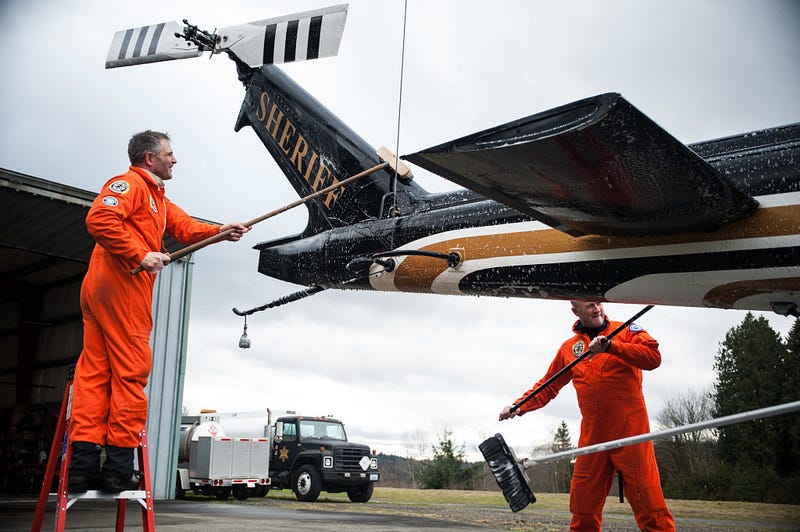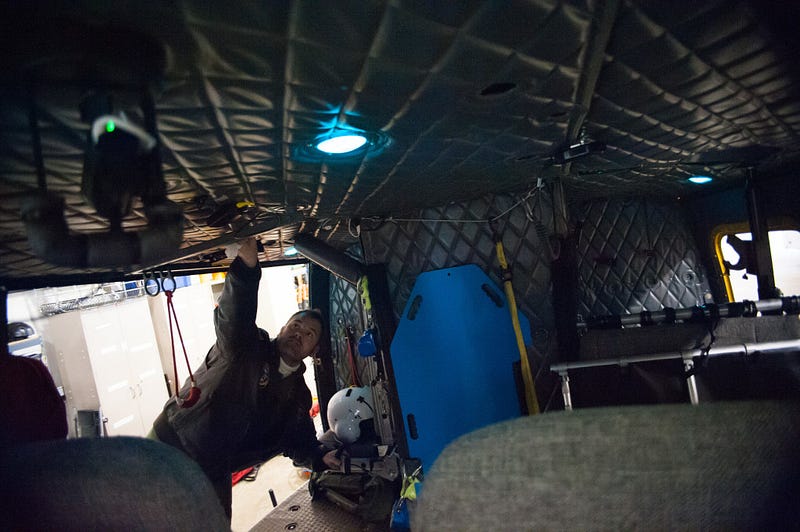That Others May Live
Snohomish County Helicopter Rescue volunteers put their lives on the line for those who are lost or injured in the wilderness
STORY AND PHOTOS BY KYRA BETTERIDGE
“Miss, I’m with search and rescue. I’m here to help you, alright?” a man with a Norwegian accent and wearing an orange jumpsuit says.
He approaches me carrying what looks like a large red sling with three metal rings and a large carabineer attached to it.
“I’m going to put this on you, just put your arms through here. Don’t try and get into the helicopter, they’ll tell you where to go. Don’t grab onto anything, just keep your hands right here,” Oyvind Henningsen says, pointing to a spot on the suit near my clavicle.
Henningsen, a rescue technician with the Snohomish County Helicopter Rescue Team, secures the screamer suit around me and clips me onto the hoist. The crew chief, Deputy Beau Beckner, uses the controls inside of the helicopter to power the hoist and my feet lift off of the hangar floor.
As I dangle three feet off of the floor I am pulled into the helicopter by Ernie Zeller, another rescue technician, and strapped into a seat. The crew has passed this part of their training with flying colors.
The Snohomish County Helicopter Rescue Team is one of seven search-and-rescue groups that make up the Snohomish County Volunteer Search and Rescue. Volunteers from a variety of mountaineering and rescue backgrounds primarily staff the organization. Other comrades come from the Snohomish County Sheriff’s Office.
Services provided by the Helicopter Rescue Team, and other branches of search-and-rescue, are, by law, free of charge. Henningson says some people think they have to pay, making them hesitant to ask for help.
The organization provides services to 13 counties in Washington State despite losing federal funding in 2013. Financial support for the organization now comes through the county government and donations from the community and volunteers.

Taylor’s Landing
Search-and-rescue organizations share an operations base at Taylor’s Landing, which is owned by the volunteers of the organizations. There are three main buildings at Taylor’s Landing, one being the hangar that houses the two helicopters used by the Helicopter Rescue Team and the Snohomish County Sheriff’s Office.
SnoHawk 1 and SnoHawk 10 reside here, poise near the massive garage door that leads to the landing pad. The larger of the two, SnoHawk 10, is the main helicopter used by the Helicopter Rescue Team because of its size, ability to reach higher altitudes and hoist capabilities. SnoHawk 1 is mainly used for search and police missions.
SnoHawk 1 began its career during the war in Vietnam as a quiet helicopter designed for CIA missions into dangerous territory. Only four or five helicopters like SnoHawk 1 were ever made, says Deputy Bill Quistorf, one of two chief pilots with the Helicopter Rescue Team.
The hangar is also home to an array of equipment and vehicles utilized by the search-and-rescue teams, including two aquatic hovercrafts.
A hulking metal helicopter sits atop a weathered wood and metal tower at the top of the hill behind the landing’s main building. Its blades have been removed and the elements have left their mark, but the light of the setting sun casts the helicopter in bronze.
It no longer flies, but the decommissioned helicopter on the tower still serves a role for the Helicopter Rescue Team. Crew members use the helicopter and tower to practice rappelling, ascending cliff faces and various other skills used during helicopter rescue missions.
This training option is a good alternative to training on the SnoHawk 10, which costs $1,200 per hour to operate, Henningsen says.

The Team
The helicopter rescue team is comprised of 39 members; five paid deputies and 34 volunteers with positions such as pilot, crew chief, rescue technician, flight medic and eight ground support personnel.
There are always at least two pilots, one crew chief, one flight medic and one rescue technician on call at any time, ready to respond in case of an emergency. Volunteers must sign up for a minimum of four on-call days per month in order for the operation to run smoothly. The crews’ dedication is evident in the 80-plus annual missions.
Emergency calls for helicopter rescues are first placed to 911. If a helicopter rescue is needed, the sheriff’s office at Taylor’s Landing is called and a page is sent out to crew members, who then confirm they will respond.
When a volunteer is on call they must stay within 20–25 minutes driving range of Taylor’s Landing in case a call comes in. Henningsen says being a part of the team is quite a committed part of people’s lives.
“You have to leave work when you’re on call” rescue technician Edwin Prada says.
“If you’re on duty and the page goes off you can’t say ‘Well, I’m not going to go,’” Henningsen adds.
The crew will gather to be briefed on the mission that awaits them after getting a call. They often will also go through a quick rehearsal on the landing pad before they deploy. When the crew arrives at the scene they assess the best way to access the patient. If there is room they will land or attempt to hover close to the ground. Performing a hoist rappel of the crew is saved as a last resort.
It is important for crew members to remain calm and relaxed as they come in to respond for a call.
“If you hurry things are going to go wrong, and they’re going to go wrong in a hurry,” Henningsen says.

When Things Go Wrong
A challenge that the pilots face on rescue missions is one that is often invisible. Air turbulence and windy conditions can make rescue missions a challenge, if not completely impossible.
“There are some times the wind is just too much and I can’t hold the aircraft in position because it’s just gusting too much,” Quistorf says. “It’s pretty rare, but I have been overhead and, you know, looking at a patient on top of the mountain and I just can’t help them out.”
It can be difficult for the crew when they are unable to help rescue someone, or a search turns up empty, but they do as much as they can safely.
“I call it a horrible honor when you’re talking with family of people who didn’t make it,” Wikstrom says.
Often the emergency calls the team responds to come from experienced men and women who have fallen victim to unfortunate accidents. Just like the people they rescue, the crew itself is not impervious to unlucky accidents.
“The things that go on inside and outside of that helicopter go very fast and it can be very unforgiving,” Wikstrom says. “There are high risks associated with this kind of function and it’s important to have a strong crew.”
During a rescue mission at Wallace Falls while attempting to rescue a young boy trapped on a ledge near the waterfall the crew experienced catastrophe. Henningsen’s rope was damaged by rocks around the falls while trying to rescue the boy, causing him to plunge into the rushing water.
Henningsen was swept toward the edge of the river and avoided going over the falls, but it was a narrow escape. Had he gone over, the team would have been faced with a devastating dilemma.
“Someone would have had to make the choice,” Wikstrom says. “Let him hang there and drown, in the dark, in that waterfall. Or cut him loose and let him fall, where he might drown too.”
Wikstrom is grateful he never had to make that choice.

Preventing Accidents
While accidents are impossible to predict, hikers and mountaineers can take steps to remain safe on their adventures.
“The best piece of advice that I have is don’t travel too far in the backcountry alone because if something does happen to you there’s no one to go back or signal out that you’re in distress or you’re incapacitated,” Quistorf says.
Quistorf says that, if possible, a small fire or waving a bright article of clothing can help the helicopter team to spot people on the ground in need of help and being searched for.
The Helicopter Rescue Team is sometimes the last lifeline for people after an accident and the team takes this responsibility to heart. They are ready at the drop of a hat, or the ring of a cell phone, to respond in the case of an emergency. They know that what they do can often mean the difference between life and death.
The volunteer rescue crews exemplify the mission statement sewn onto their patches and printed across the emblem marking the entrance to Taylor’s Landing. The words, displayed on a red banner beneath a helicopter with wings, read “Snohomish County Search — Rescue: That Others May Live”.

